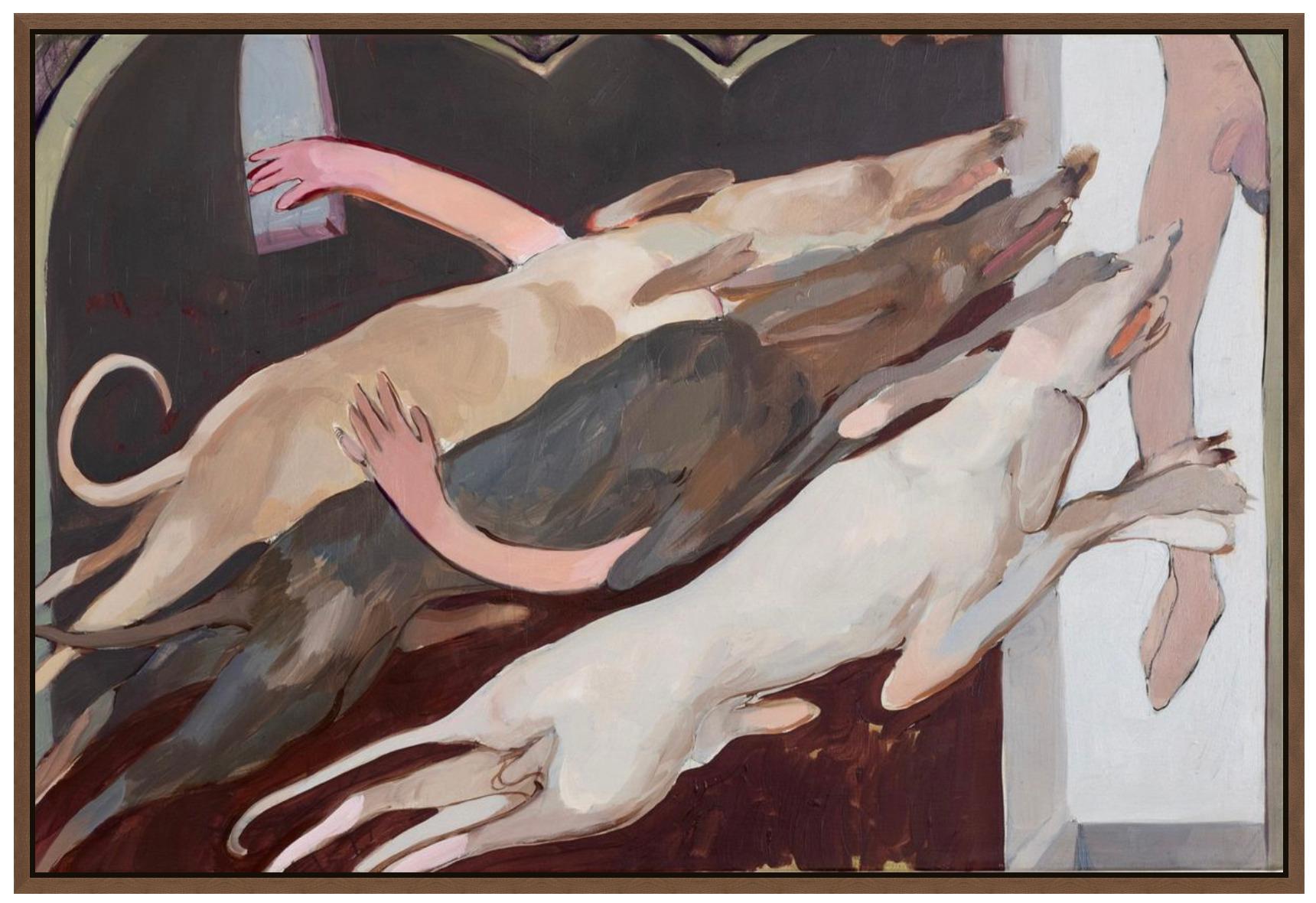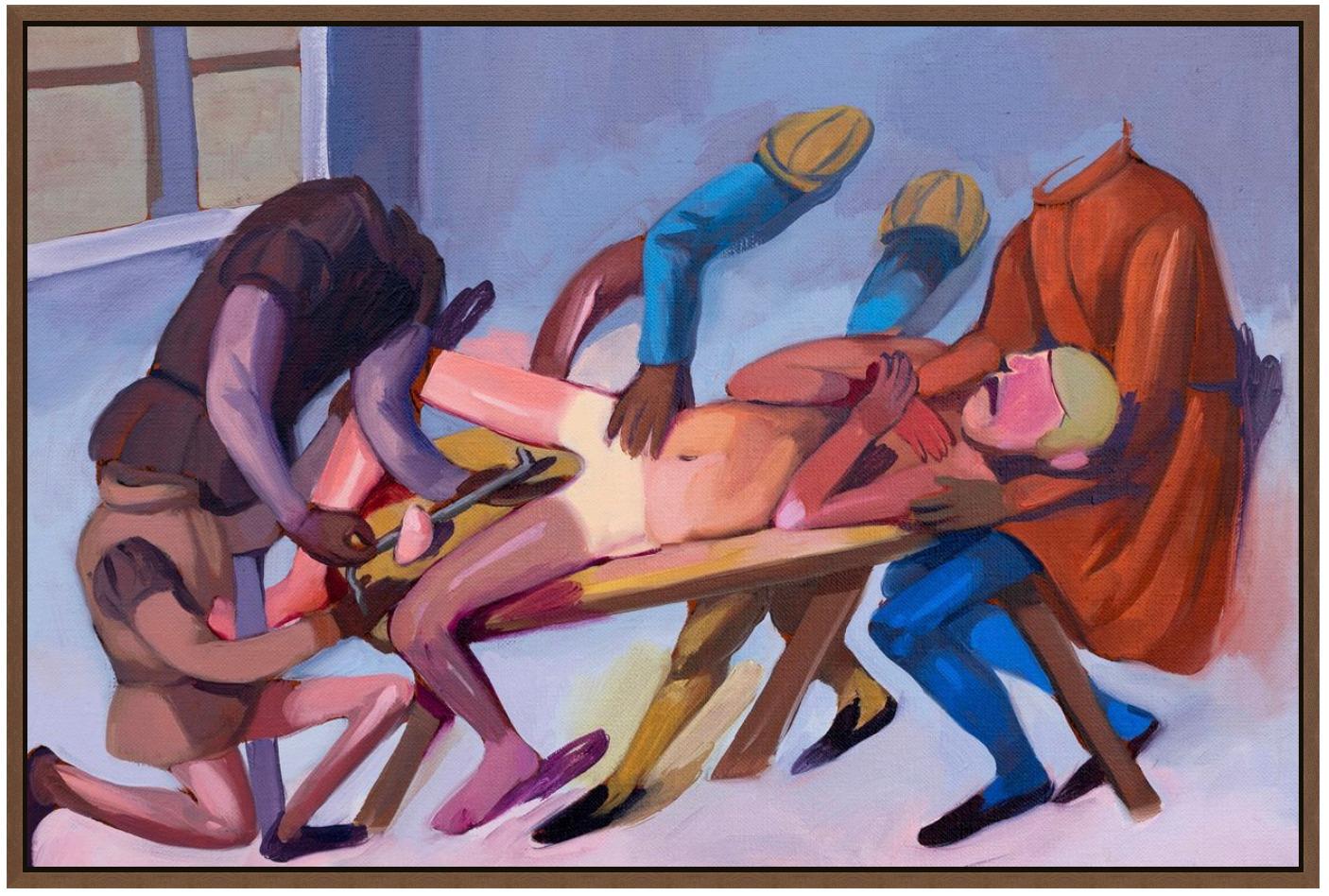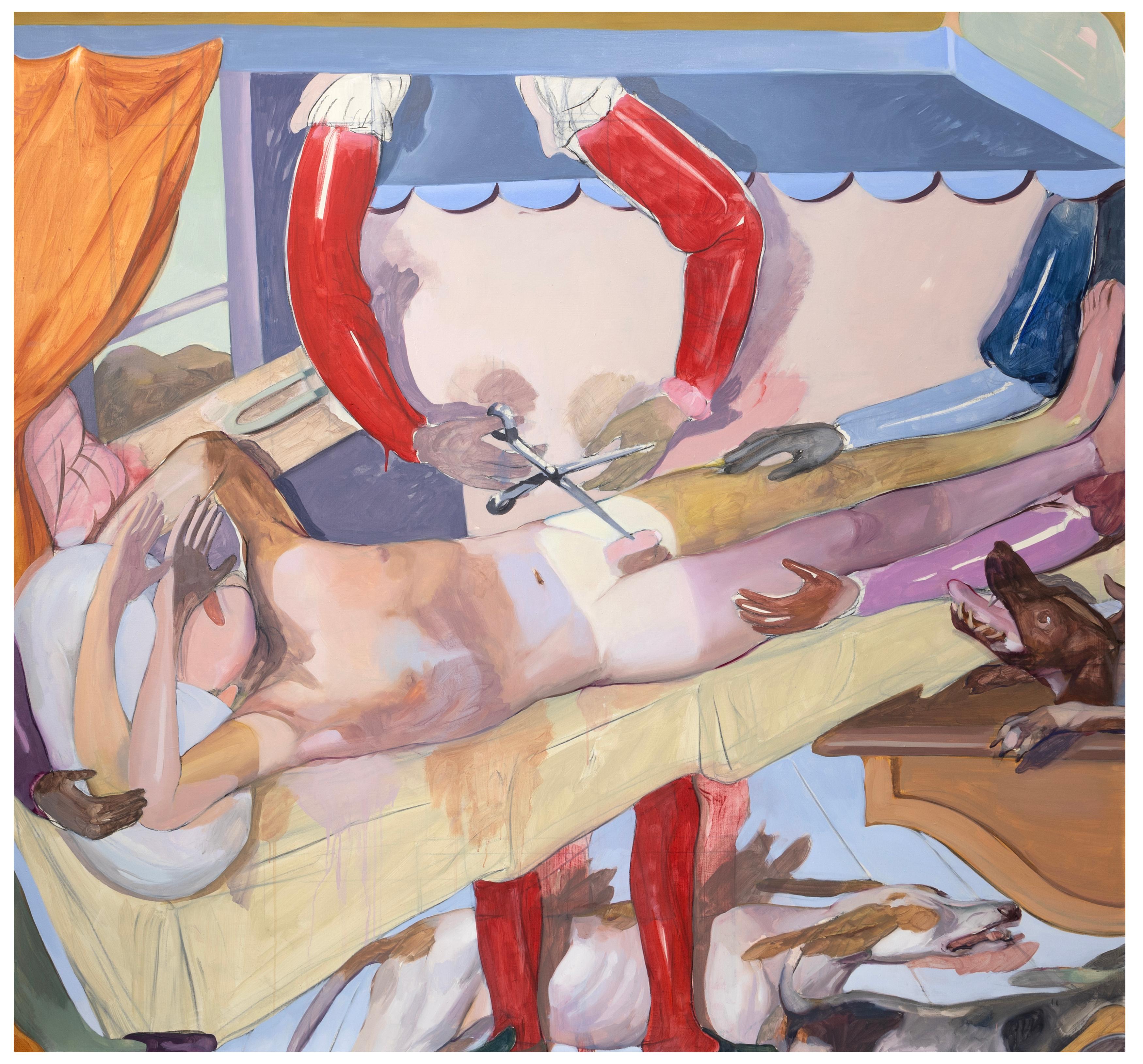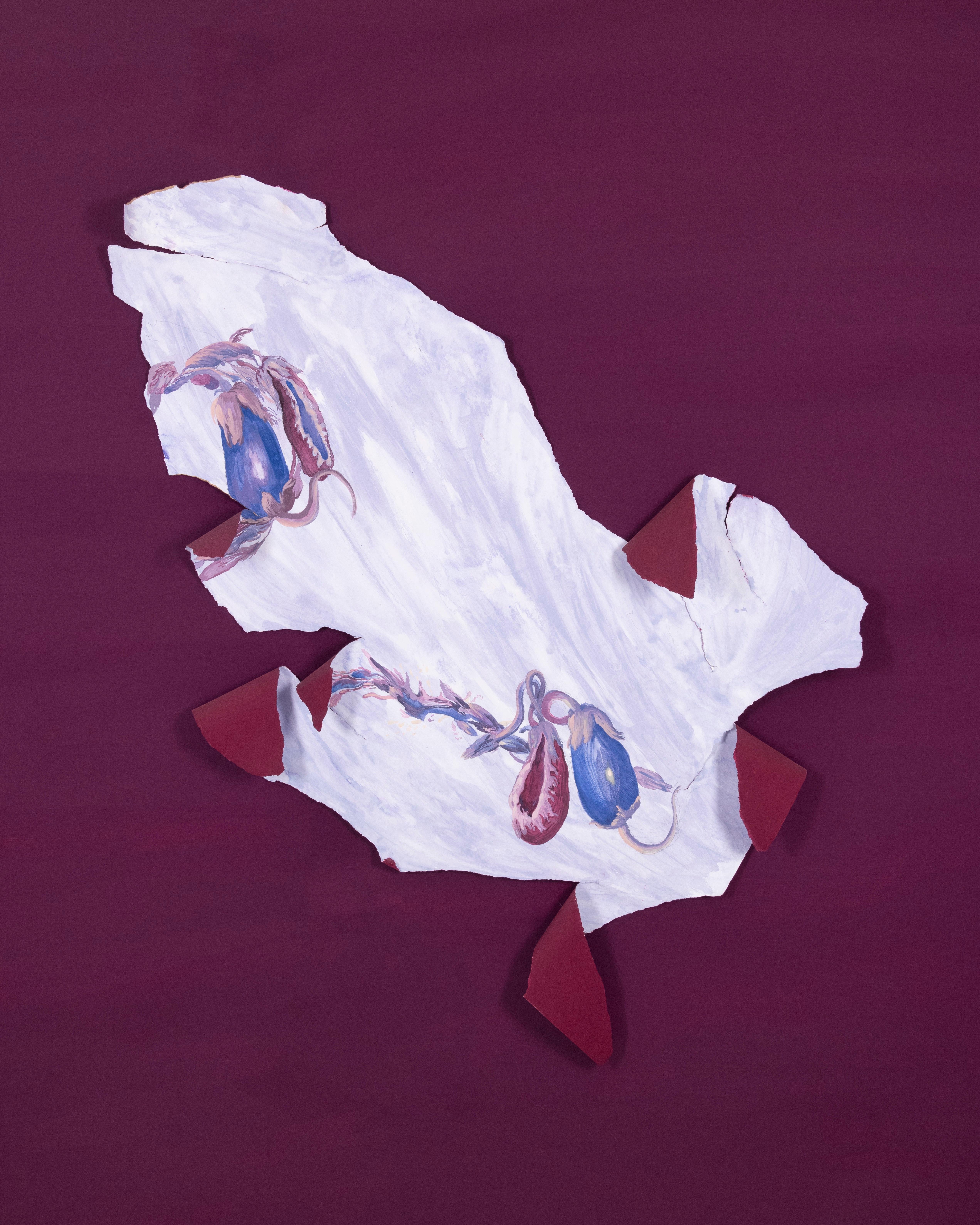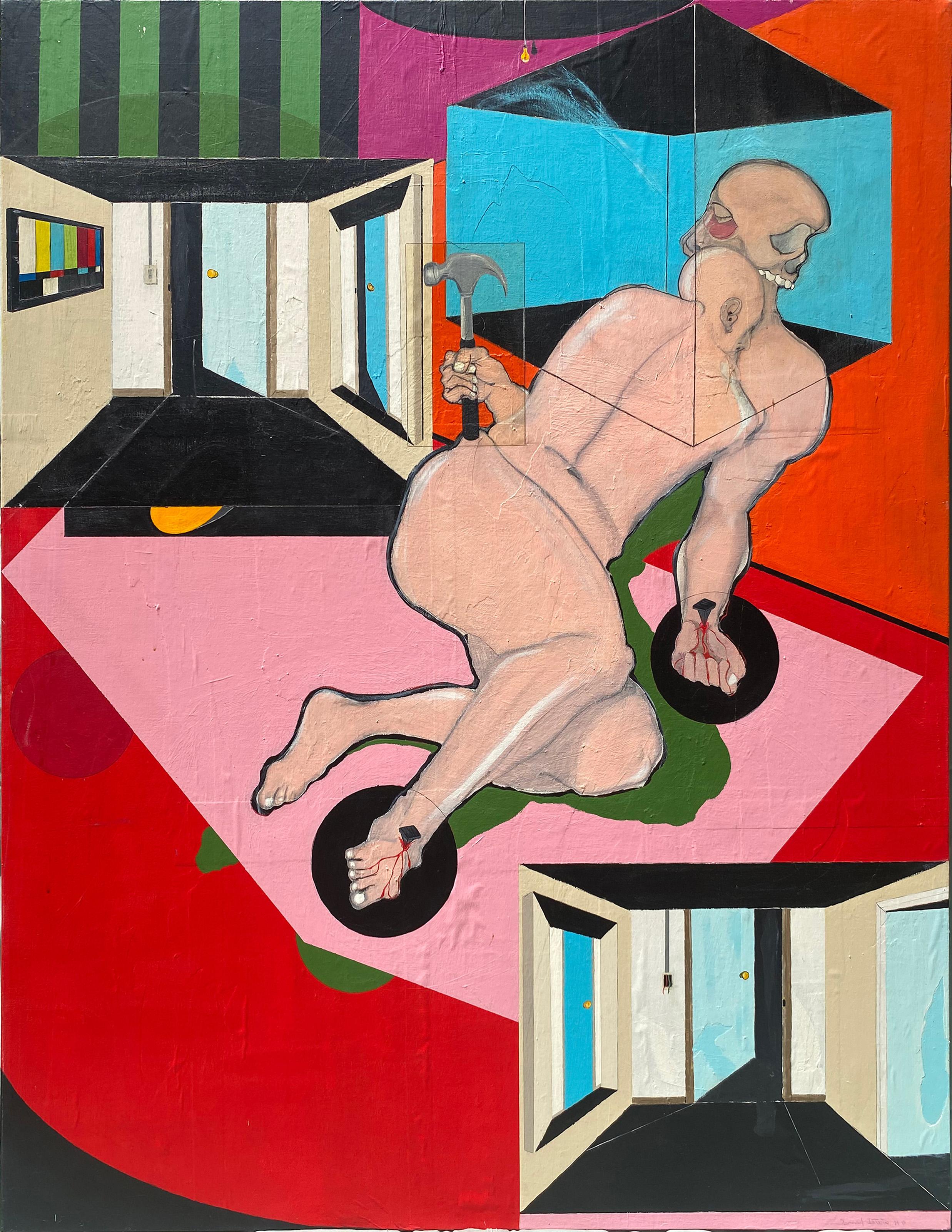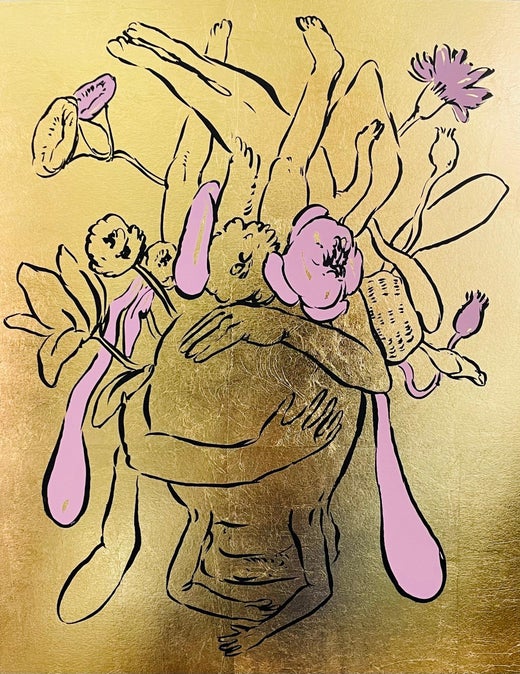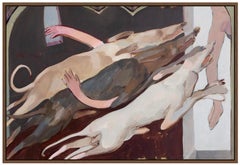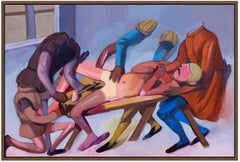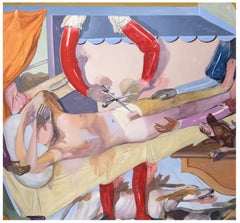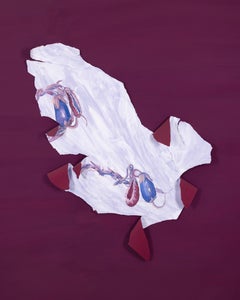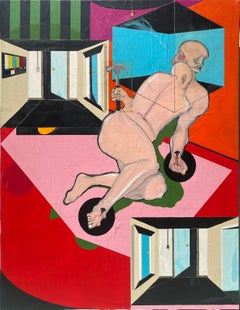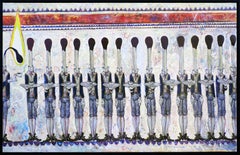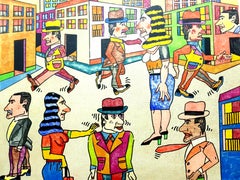Items Similar to "La mesa fordista I" hands, beige, surreal
Want more images or videos?
Request additional images or videos from the seller
1 of 2
Gonzalo García"La mesa fordista I" hands, beige, surreal2024
2024
$950
£720.23
€830.24
CA$1,337.92
A$1,483.66
CHF 779.55
MX$18,127.77
NOK 9,753.26
SEK 9,155.10
DKK 6,197.87
About the Item
Gonzalo García’s work explores the influence of Western culture and European painting on Mexican art, focusing on 17th- and 18th-century still lifes, Flemish Baroque bodegones, and more recently, 15th-century medieval painting. He reimagines symbolic elements, textiles, and furniture from these styles within his own queer perspective, creating pastel-toned works that contrast historical aesthetics with his personal experiences as a contemporary queer artist.
In recent years, García has developed a project examining the dialogue between 1970s Mexican cinema and contemporary painting. Drawing on films as cultural records, he uses them to reflect on memory and the societal concerns of their time. His series Cachorros intertwines two sources: Alfredo González Reynoso’s 2022 essay El Nuevo Orden que Algunos Soñaron and Jorge Fons’ 1973 film Los Cachorros. Reynoso critiques Michel Franco’s film Nuevo Orden (2020), highlighting how it imposes a “docile” role of martyrdom on the oppressed, reinforcing internalized whiteness and submission in colonized societies. Meanwhile, Fons’ film portrays an “ignoble savage” through a violent dog that disrupts and threatens human ideals of control.
García parallels the concepts of the noble and ignoble savage, reversing roles of oppressor and oppressed, prey and predator. His paintings incorporate references to medieval scenes of castration and circumcision, depicting intimate, tense moments where hunting dogs and dismembered limbs confront figures symbolizing power. Through this, García critiques societal expectations of obedience and submission, creating a provocative dialogue between past and present.
#QueerArt #LGBT+
Gonzalo studied Visual Arts at the Instituto Allende University, in San Miguel de Allende, Guanajuato. His most recent work addresses different social and historical issues in Mexico based on novels written in the 40s and movies from the 70s and 80s of our country. In his career, he has had seven individual exhibitions in Mexico and more than 15 collective exhibitions including various museums in Querétaro, Monterrey, Guadalajara, Sweden, Spain, and recently in New York and California, in the US. In 2013 he had a residency at the Swedish Watercolor Museum, near the city of Gothenburg, and obtained the FONCA "Young Creators" Scholarship for the first time, in the discipline of painting. Likewise, he has been selected in several biennials throughout his career, such as the last XVII Rufino Tamayo Biennial of 2016-2017 and the José y Tomás Chávez Morado Biennial of 2018, where he obtained an honorable mention, as well as the last VI Pedro Coronel Biennial. from Zacatecas. In 2018 he obtained the FONCA "Young Creators" Scholarship for the second time in the discipline of painting. In that same year, he was selected in the "Julio Castillo" Biennial of painting in the city of Querétaro, exhibited at the Libertad Gallery, as well as in a pop-up show of contemporary Mexican painting in Los Angeles, California, with the Emilia Cohen Gallery. In 2019 he participated in several group exhibitions in Edo. from Mexico and CDMX, such as the collective painting exhibition "New Skin for an old ceremony" at the Karen Huber Gallery, and the FAIN Fair (1st Edition). Last year he had his seventh individual exhibition at the Arte Actual Mexicano Gallery, in Mty, N.L., entitled "Fires" and had the support of the FONCA Young Creators Scholarship for the third time, in the discipline of painting, in addition to receiving Mention honorary in the 4th Edition of the Lumen Biennial, "Panorama", still exhibited at the beginning of 2022 at the Museum of the City of Mexico City. Finally, in August of this year, he had his seventh individual exhibition at Galería Loot, in Col. Roma in Mexico City.
About the Seller
5.0
Vetted Professional Seller
Every seller passes strict standards for authenticity and reliability
Established in 2018
1stDibs seller since 2022
33 sales on 1stDibs
Typical response time: <1 hour
- ShippingRetrieving quote...Shipping from: Ciudad de México, Mexico
- Return Policy
Authenticity Guarantee
In the unlikely event there’s an issue with an item’s authenticity, contact us within 1 year for a full refund. DetailsMoney-Back Guarantee
If your item is not as described, is damaged in transit, or does not arrive, contact us within 7 days for a full refund. Details24-Hour Cancellation
You have a 24-hour grace period in which to reconsider your purchase, with no questions asked.Vetted Professional Sellers
Our world-class sellers must adhere to strict standards for service and quality, maintaining the integrity of our listings.Price-Match Guarantee
If you find that a seller listed the same item for a lower price elsewhere, we’ll match it.Trusted Global Delivery
Our best-in-class carrier network provides specialized shipping options worldwide, including custom delivery.More From This Seller
View All"Autopsia al salvaje II" dogs, savage, surreal, beige
Located in Ciudad de México, MX
Gonzalo García’s work explores the influence of Western culture and European painting on Mexican art, focusing on 17th- and 18th-century still lifes, Flemish Baroque bodegones, and more recently, 15th-century medieval painting. He reimagines symbolic elements, textiles, and furniture from these styles within his own queer perspective, creating pastel-toned works that contrast historical aesthetics with his personal experiences as a contemporary queer artist.
In recent years, García has developed a project examining the dialogue between 1970s Mexican cinema and contemporary painting. Drawing on films as cultural records, he uses them to reflect on memory and the societal concerns of their time. His series Cachorros intertwines two sources: Alfredo González...
Category
2010s Figurative Paintings
Materials
Linen, Oil
"Autopsia al sauvage IV" surreal, body, pastel colors
Located in Ciudad de México, MX
Gonzalo García’s work explores the influence of Western culture and European painting on Mexican art, focusing on 17th- and 18th-century still lifes, Flemish Baroque bodegones, and more recently, 15th-century medieval painting. He reimagines symbolic elements, textiles, and furniture from these styles within his own queer perspective, creating pastel-toned works that contrast historical aesthetics with his personal experiences as a contemporary queer artist.
In recent years, García has developed a project examining the dialogue between 1970s Mexican cinema and contemporary painting. Drawing on films as cultural records, he uses them to reflect on memory and the societal concerns of their time. His series Cachorros intertwines two sources: Alfredo González...
Category
2010s Figurative Paintings
Materials
Linen, Oil
"Autopsia al sauvage con traje de latex I" body, nude, pastel colors
Located in Ciudad de México, MX
Gonzalo García’s work explores the influence of Western culture and European painting on Mexican art, focusing on 17th- and 18th-century still lifes, Flemish Baroque bodegones, and more recently, 15th-century medieval painting. He reimagines symbolic elements, textiles, and furniture from these styles within his own queer perspective, creating pastel-toned works that contrast historical aesthetics with his personal experiences as a contemporary queer artist.
In recent years, García has developed a project examining the dialogue between 1970s Mexican cinema and contemporary painting. Drawing on films as cultural records, he uses them to reflect on memory and the societal concerns of their time. His series Cachorros intertwines two sources: Alfredo González...
Category
2010s Figurative Paintings
Materials
Linen, Oil
"Fragmento de memoria con berenjenas", tapestry, allegory, bouquets, figurative
Located in Ciudad de México, MX
Enveloped by outstretched paintings, Gonzalo García reveals the ever-present ghosts of our past and present in a delicate swirl of color, light, and flesh. These deeply visceral disp...
Category
2010s Contemporary Figurative Paintings
Materials
Acrylic, Paper
Panejos and cojaros with legs VI/ figurative birds, contemporary art
Located in Ciudad de México, MX
Enveloped by outstretched paintings, Gonzalo García reveals the ever-present ghosts of our past and present in a delicate swirl of color, light, and flesh. These deeply visceral disp...
Category
20th Century Contemporary Figurative Paintings
Materials
Linen, Oil
"Autopsia al salvaje I" nude painting, dog, pastel colors
Located in Ciudad de México, MX
Gonzalo García’s work explores the influence of Western culture and European painting on Mexican art, focusing on 17th- and 18th-century still lifes, Flemish Baroque bodegones, and m...
Category
2010s Figurative Paintings
Materials
Linen, Oil
You May Also Like
Cabeza, Oil Painting by Rodolfo Opazo Bernales
By Rodolfo Opazo
Located in Long Island City, NY
Artist: Rodolfo Opazo, Chilean (1935 - )
Title: Cabeza
Year: 1983
Medium: Oil on Canvas, signed l.l. and verso
Size: 39 x 32 inches
Category
1980s Surrealist Figurative Paintings
Materials
Canvas, Oil
El Cuadvado, Surrealist Oil and Acrylic Painting by Samuel Iztueta
Located in Long Island City, NY
Samuel Iztueta, American - El Cuadvado, Year: 2013, Medium: Oil and Acrylic on Canvas, signed and titled with writing verso, Size: 60 x 48 in. (152.4 x 121.92 cm)
Category
2010s Surrealist Figurative Paintings
Materials
Oil, Acrylic
"De Sovediencia III" Contemporary Abstract Figurative Surrealist Match Painting
Located in Houston, TX
Figurative surrealist oil painting by Cuban artist Douglas Perez Castro. This painting depicts a scene with several figures with matches as heads ...
Category
2010s Contemporary Figurative Paintings
Materials
Oil
Antonio Segui - Distraido - Oil on Canvas
By Antonio Seguí
Located in Collonge Bellerive, Geneve, CH
Antonio Segui
38 x 46 cm
Distraido
Oil on Canvas
Signed and Dated on the back
Antonio Segui Biography
Born in Córdoba, Argentina in 1934, Antonio Seguí currently lives and works in Paris. He studied at the San Fernando Academy in Madrid, Spain as well as the Ecole des Beaux-Arts in Paris, France. His first solo exhibition was in Argentina at age 23.
Antonio Seguí is one of the most internationally renowned Argentinian artists. He began his artistic endeavors at a young age after leaving Argentina to travel the world and study art. His journeys through Latin America, Europe and Africa exposed him to new ideas and encouraged his culturally diverse approach to art.
Influenced by artists like Fernand Leger and Diego Rivera, Seguí’s work is generally satirical, critiquing society and human nature. In a pre-computer age, the artist created a vocabulary that is now being explored by a new generation of artists through comics and Manga, yet his visual language and social commentaries remain poignant, both symbolically and literally.
Throughout his career, Seguí has developed a fascination for urban life, creating in his work the idea of the “everyman.” The city movement, the fast pace at which life happens and the people who live in these urban spaces are some of the elements that constitute the world depicted in his paintings. It is a prototypical realm inhabited by speedy automatons that take immutable routes leading nowhere. Up close, each figure is an individual, walking down dark alleys, pointing, waving and emerging from potholes. But from a distance, the individuals morph into complex patterns swallowed up in a labyrinth of buildings and cookie-cutter trees.
Utilizing cubist techniques, Seguí’s repeated elements give shape to the cities causing planes to vibrate between line and color. Numerous perspectives unfold with each vibration and reflect the many angles of life of the urban man. Always in action, the little figures trample, tip-toe, dodge and advance through Seguí’s imaginary metropolis of life.
His work is representated on a series of narratives and criticisms reflected on paintings that show many little men, dressed in 20's style clothes. He uses his own recourse based on comic strip characters, texts, arrows and various signs, juxtaposed onto the figures that resemble comic strip style language.
Seguí’s work is collected and exhibited worldwide in places such as the MoMA, New York; Art Museum of the Americas, Washington, D.C.; Frissiras Museum, Athens, Greece; Museo de Arte Moderno de Buenos Aires, Argentina; Museum der Moderne Salzburg, Austria; Museum of Modern Art Dubrovnik, Croatia; and Museo Tamayo, Mexico City, Mexico. The Musée National d´Art Moderne, Paris organized a retrospective of his works on paper in 2005. A monograph on the artist by Daniel Abadie was published in 2010 by Hazan.
Antonio Segui Resumé
1995
Art Miami '95, USA.
S. Zannettacci, Geneva, Switzerland
Marwan Hoss, Paris, France
Gallerie du Cirque Divers, Belgium
Le Moulin du Roc, France
Fundacao C. Gulbenkaian, Portugal
Gallerie J. Rubeiz, Beirut, Liban
1994
F. Santos, Portugal
E. Franck Gallery, Belgium
1993
Galleria San Carlo, Milan, Italy
Galería I. Vega, Puerto Rico
Winance-Sabbe, Belgium
FIAC, Paris, France
1992
Casa Rosada, Buenos Aires, Argentina
Espace Julio Gonzales...
Category
2010s Modern Figurative Paintings
Materials
Oil
Social Losas I - figurative vertical Painting beige and light blue
Located in Miami, FL
Painting: Oil and Palladium on Canvas
Category
2010s Figurative Paintings
Materials
Canvas, Oil
2873 The ilussionist tamer, Painting, Oil on Canvas
By Andres Vivo
Located in Yardley, PA
Belongs to my "human behaviour series" .Inspired by the dramatics artworks of Francisco Goya. :: Painting :: Surrealism :: This piece comes with an offi...
Category
2010s Surrealist Figurative Paintings
Materials
Oil
More Ways To Browse
Artist Garcia
Flemish Baroque
Framed Mexican Textile
18th Century Dog Paintings
18th Century Hunting Paintings
Mexican Baroque
Fly Fishing Art
Spanish Flamenco Dancers
Vintage Rodeo
Britto Romero
Clown Head
Francis Butler
Keller Paris
Mexican Female Nude Paintings
Minerva Painting
New York Stock Exchange
Pin Up Girl
Galerie Charpentier
